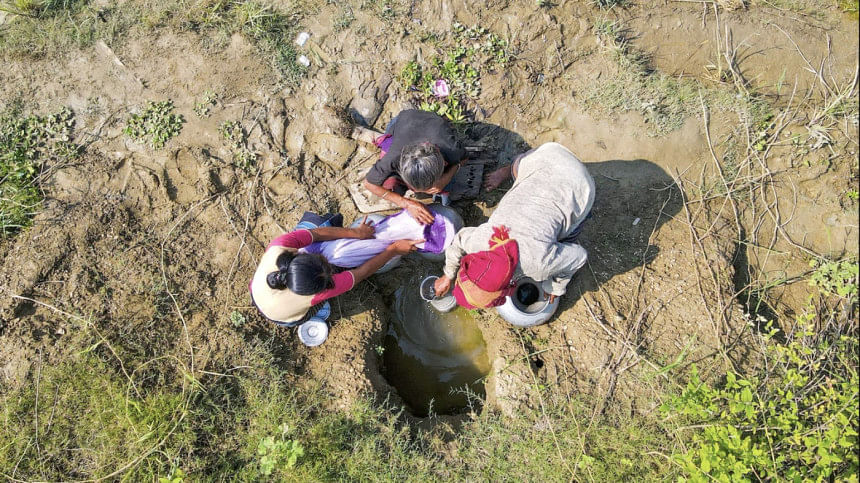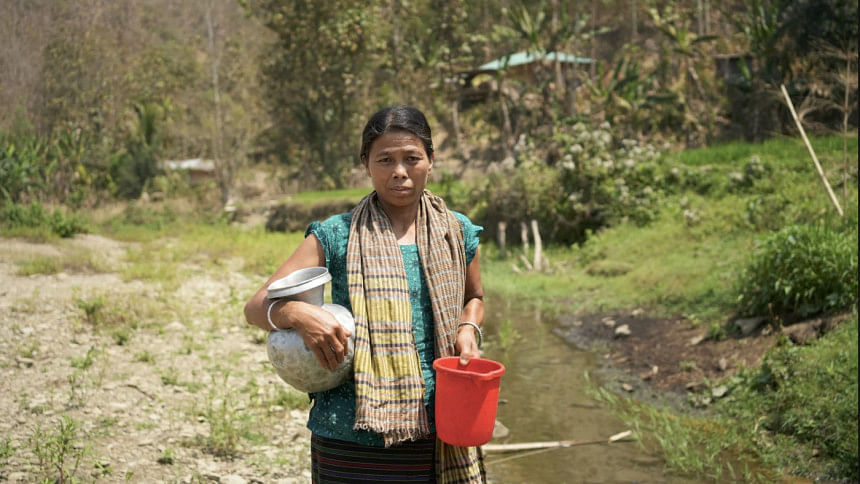Why we need to hear women’s voices from the hills

When we talk about Bangladesh's water crisis, the discourse usually falls on the coastal belt, where salinity, sea-level rise, and water scarcity dominate headlines. Yet another crisis is quietly unfolding in the Chittagong Hill Tracts (CHT), where long-running mountain streams are drying slowly but inexorably, pushing Indigenous communities deeper into precarity. This is not merely an environmental issue, but also a deeply gendered one.
Take Shishikkha Chakma from Bilaichhari. Her home lies a hill away from the nearest trickle of water. On a regular day, she makes the climb twice; when guests visit, it becomes six. The water she hauls is used strictly for cooking and drinking. To bathe or wash clothes, she must walk farther, facing multiple risks. "Most of our lands lie vacant," says fellow villager Proshanto Chakma. "We don't have enough water to cultivate."
Across the three CHT districts of Khagrachhari, Rangamati, and Bandarban, women like Shishikkha begin their days with long, perilous, potentially hazardous treks. As the once-reliable streams fade to muddy trickles, the walks grow longer.
But these women are far from powerless. Indigenous communities, many of whom are matriarchs, have always practised adapting to climate change through ancestral knowledge. In Bandarban alone, more than 55 crop varieties and 289 medicinal or edible plants are cultivated using a deep understanding of altitude, soil, wind, and microclimates. This knowledge, passed down orally, has grown from the land itself. It is essential and invaluable.
CHT's Indigenous women have long been ecological caretakers, building bamboo check dams, harvesting rainwater, and relying on knowledge passed down through matriarchal lines, like reading tree canopies, bird calls, and forest signs to find hidden springs. They know which forest plants heal, which nourish. This deep ecological wisdom—relational, practical, and spiritual—is rarely acknowledged in climate fund discourses and development frameworks.

The water scarcity in CHT stems from decades of deforestation, ecological mismanagement, and the marginalisation of Indigenous land practices. Forests have been stripped relentlessly. Jhum cultivation, once grounded in sacred rotational cycles, has been compressed from 15-year intervals to just two or three, leaving the soil too degraded to recover. Where fallow periods once allowed land to heal, today's intensification erodes topsoil and drains fertility.
The Asian Development Bank (2011) notes that CHT's watershed degradation stems from deforestation, road construction, short-rotation jhum, and the cultivation of root crops like cassava and turmeric on steep slopes. Modifications of traditional practices have led to landslides, biodiversity loss, and diminished aquifer recharge. The International Soil Reference and Information Centre's Global Assessment of Soil Degradation report (2006) identifies CHT soils as shallow, low in organic matter, and highly susceptible to erosion if forest cover is lost.
From my field visits, I realised another overlooked culprit is the unchecked spread of teak plantations. Touted for timber, these non-native trees are poorly suited to the CHT's ecology. They consume large amounts of water, crowd out native species, and do little to stabilise soil. Their oily, waxy leaves repel water, causing surface runoff rather than allowing it to seep into the ground. Ironically, many of these plantations were funded as "green" afforestation projects, equating monoculture with ecological health.
Where groves were once considered sacred and served as natural reservoirs, state-driven afforestation and market forestry have turned biodiverse systems into commercial monocultures. The result is cracked soils, silenced springs, and parched hillsides.
In Rangamati, only 63 percent of the population has access to safe drinking water. Deep wells, even when available, offer no certainty in a landscape shaped by landslides and erratic rainfall. Girls skip school, and elders fall ill. Still, women continue to build clay-lined pots, shaded wells, bamboo spouts—quiet acts shaped by care and underlined by community resistance.
Before colonial forestry and market logic affected the hills, Indigenous cosmologies governed land use. Forests were sacred and responsive. Land was not measured by yield, but by relationship. Indigenous studies scholar Ranjan Datta documents how these ecologies of care were systematically eroded by brickfields, plantations, and NGO schemes that favoured output over reciprocity.

Still, many women remember. They remember Bogle Puja and Hanei Puja, where land and spirit were one. They remember that sustainability was never about metrics, but kinship. This knowledge lives on—in bodies, rituals, and the quiet, persistent tending of place and selves.
Historically, ecological governance in the CHT followed matrilineal rhythms. Women planted by the moon, made offerings before harvests, and treated land not as a resource, but as kin. Now, that balance is unravelling. Climate change accelerates displacement already driven by land grabs, militarised development, and the dismissal of Indigenous practice. Despite being frontline stewards, Indigenous women remain absent from forest and water governance. There is no systematic effort by the government to document and integrate Indigenous knowledge in any sector plan or biodiversity conservation planning.
While climate finance conversations increasingly include coastal women, hill women remain largely invisible within a system that does not recognise their ancestral kinship with the land.
To move forward, we must go beyond the convenient trope of resilience and focus on justice. Centring Indigenous women as knowledge holders, protectors, and leaders—not simply as token guest speakers—is a start. Their governance systems, rooted in reciprocity, offer models of survival we can no longer afford to ignore.
As Datta reminds us, sustainability without justice is abandonment. The drying streams are not just symptoms of climate collapse; they are signs of what we've been apathetic to.
Dibarah Mahboob is filmmaker, artist, and visual anthropology postgraduate from Goldsmiths, University of London.
Views expressed in this article are the author's own.
Follow The Daily Star Opinion on Facebook for the latest opinions, commentaries and analyses by experts and professionals. To contribute your article or letter to The Daily Star Opinion, see our guidelines for submission.

 For all latest news, follow The Daily Star's Google News channel.
For all latest news, follow The Daily Star's Google News channel. 








Comments